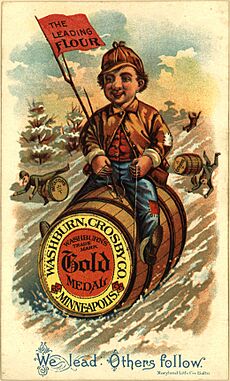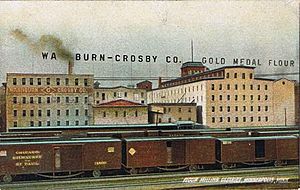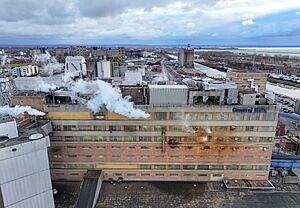General Mills facts for kids
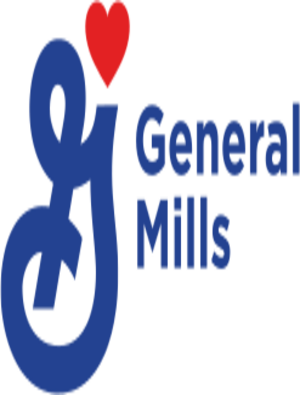
Logo used since December 2017
|
|
|
Formerly
|
|
|---|---|
| Public | |
| Traded as | |
| Industry | Food processing |
| Founded | 1856 (as Minneapolis Milling Company) 1877 (as Washburn-Crosby Company) 1928 (as General Mills) Minneapolis, Minnesota, U.S. |
| Founders |
|
| Headquarters |
,
U.S.
|
|
Area served
|
Worldwide |
|
Key people
|
Jeffrey Harmening (chairman and CEO) |
| Products | Baking mixes, breakfast cereals, yogurt, refrigerated dough, soup, pizza, snack foods, ice cream, soy products, vegetables, flour, other food products, |
| Revenue | |
|
Operating income
|
|
| Total assets | |
| Total equity | |
|
Number of employees
|
34,000 (May 2024) |
| Subsidiaries | Cereal Partners Worldwide (50%) |
| Footnotes / references Financials as of May 26, 2024[update]. References: |
|
General Mills, Inc. is a large American company that makes and sells many popular food products. You can find their foods in grocery stores all over the world. The company started in Minneapolis, Minnesota, near the Mississippi River. It was first known for being a big flour mill. Today, its main office is in Golden Valley, Minnesota.
General Mills makes many well-known brands. These include Gold Medal flour, Annie's Homegrown, Lärabar, Betty Crocker, Nature Valley, Totino's, Pillsbury, Old El Paso, and Häagen-Dazs. They also make many breakfast cereals like Cheerios, Wheaties, Chex, Lucky Charms, Trix, and Cocoa Puffs.
Contents
History of General Mills
General Mills has a long history, starting in the mid-1800s. It grew from a small milling company into a global food giant.
Early Beginnings: Washburn-Crosby Company
The company's story began in 1856 with the Minneapolis Milling Company. This company was started by Robert Smith. He rented out water power to flour mills in Minneapolis. Soon after, Cadwallader C. Washburn bought the company. He hired his brother, William D. Washburn, to help grow the business.
In 1866, the Washburn brothers started their own milling business. They built the Washburn "B" Mill. It was very large for its time. In 1874, they built an even bigger one, the Washburn "A" Mill.
In 1877, Washburn teamed up with John Crosby. They formed the Washburn-Crosby Company. They made flour from winter wheat. That same year, William Hood Dunwoody went to England to sell spring wheat. He was very successful.
The Great Mill Disaster and Improvements
In 1878, the "A" mill was destroyed in a flour dust explosion. Five other buildings were also ruined. This event was called the Great Mill Disaster. Sadly, 18 workers died.
After the disaster, a new mill was built right away. This new mill was much safer. It also used new technology: automatic steel rollers instead of old grinding stones. This helped them make higher quality flour. In 1880, their flour won awards, leading to the creation of the Gold Medal flour brand.
In 1924, the company bought a radio station in Minneapolis–Saint Paul called WLAG. They changed its name to WCCO, which came from "Washburn-Crosby Company."
Founding of General Mills
General Mills was officially created on June 20, 1928. James Ford Bell, who was president of Washburn-Crosby, combined Washburn-Crosby with three other mills. That same year, General Mills also bought the Wichita Mill and Elevator Company.
Shares of the new company were first sold on the New York Stock Exchange on November 30, 1928. General Mills has paid a dividend to its shareholders every year since it started. This is something only a few companies have done.
Engineering Innovations
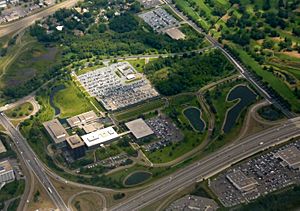
General Mills engineers created important inventions. In the 1930s, Thomas R. James invented the puffing gun. This machine made cereal pieces puff up. It was used to create Kix cereal in 1937 and Cheerios in 1941.
In 1939, Helmer Anderson created the Anderson sealer. This device used glue to seal bags of flour, which was much better than tying them with string. In 1956, General Mills also created the tear-strip for easy-to-open packages.
Aeronautical and Electronics Work
After World War II, General Mills started an Aeronautical Research Division in 1946. They worked with the United States Navy to develop high-altitude balloons, like the Skyhook balloon.
In 1956, the U.S. government used hundreds of General Mills balloons for Project Genetrix. These balloons carried cameras to take pictures over certain countries.
The General Mills Electronics division also helped develop the DSV Alvin submersible. This special underwater vehicle was used to explore the wreck of the Titanic and other deep-sea areas.
Advertising and Television
Starting in 1929, General Mills put special coupons, called Betty Crocker coupons, inside their product boxes. People could collect these coupons and use them to get discounts on houseware items from a catalog. This program ended in 2006.
General Mills sponsored the popular radio show The Lone Ranger starting in 1941. They continued to sponsor the show when it moved to television until 1961.

From 1959, General Mills sponsored the Rocky and His Friends TV series. Rocky and Bullwinkle characters appeared in many General Mills ads until 1968. The company also sponsored other cartoons like Tennessee Tuxedo.
Expanding into Toys and Restaurants
General Mills entered the toy industry in 1965 by buying Rainbow Crafts, which made Play-Doh. This purchase helped lower production costs and greatly increased sales. In 1967, they bought the Kenner toy company.
In the 1970s, General Mills released their popular "monster cereals". These cereals are still sold seasonally around Halloween.
In 1970, General Mills bought Red Lobster, which was a small restaurant chain. They helped it grow across the country. In 1982, General Mills Restaurants started a new Italian restaurant chain called Olive Garden. Later, in 1995, all these restaurants became their own separate company, Darden Restaurants.
General Mills also tried owning clothing companies like Talbots and Eddie Bauer. However, they sold these businesses after a short time.
From 1976 to 1985, General Mills was involved in a court case about the board game Monopoly. They owned the rights to the game and tried to stop others from using the word "monopoly" in other game names. The U.S. Supreme Court ruled that while General Mills owned the game Monopoly, they could not stop others from using the word "monopoly" in a game's name.
In 1985, General Mills separated its toy division into a new company called Kenner Parker Toys, Inc.
Recent History and Focus
In 1990, General Mills started a joint company with Nestlé S.A. called Cereal Partners. This company sells cereals (including many General Mills brands) outside the US and Canada under the Nestlé name.
In 2001, General Mills bought Pillsbury. Since 2004, General Mills has focused on making healthier products. They switched all their breakfast cereals to whole grains. They also reduced the sugar in cereals for children.
In 2011, General Mills announced they would use only cage-free eggs. In 2014, they bought Annie's Inc., an organic food company. This was part of their plan to grow in the natural foods market.
In 2015, General Mills promised to reduce its greenhouse gas emissions by 28% over 10 years. In 2018, the company entered the pet products industry by buying Blue Buffalo Pet Products, Inc.
General Mills has also started programs to improve soil health on farms. They plan to do this on 1 million acres of farmland by 2030. They work with a company that uses satellite imagery and weather data to measure how much carbon is stored in the soil.
In February 2020, General Mills was recognized for its efforts in corporate sustainability and water security. In 2021, General Mills bought Tyson Foods's pet treat business.
In April 2022, there were reports of people feeling sick after eating Lucky Charms cereal. The company and the FDA investigated these reports. In May 2022, General Mills bought TNT Crust, a company that supplies frozen pizza crusts. They also sold their Hamburger Helper and Suddenly Salad businesses.
In November 2023, General Mills acquired a pet supplement business called Fera Pets, Inc. In September 2024, General Mills announced it would sell its North American yogurt business. The sale of its Canadian yogurt division was completed in January 2025.
Brands
General Mills makes many different types of food products.
Breakfast Cereals
General Mills's breakfast cereals include:
- Basic 4
- Boo-Berry
- Cascadian Farm
- Cheerios and its variants
- Chex and its variants
- Cinnamon Toast Crunch
- Cocoa Puffs
- Cookie Crisp
- Count Chocula
- Fiber One / Fibre One
- Franken-Berry
- French Toast Crunch
- Gold Flakes
- Honey Nut Clusters
- Kix
- Lucky Charms
- Morning Summit
- Oatmeal Crisp
- Raisin Nut Bran
- Reese's Puffs
- Total
- Trix
- Wheaties
Some cereals are sold outside the US and Canada by Cereal Partners under the Nestlé brand.
Cereal Collaborations
General Mills has teamed up with other companies to create special cereals:
| Cereal name | Collaboration with | Date launched |
|---|---|---|
| Hershey Kisses Cereal | Hershey's | January 2020 |
| IHOP Blueberry and Syrup Mini Pancake Cereal | IHOP | December 2022 |
| Kelce Mix Cereal | Travis and Jason Kelce | September 2024 |
Grain Snacks
The company's grain-snack brands include:
- Bugles
- Cascadian Farms
- Chex Mix
- Gardetto's
- Nature Valley
- Fiber One / Fibre One bars
Baking Goods
The company's baking-goods brands include:
- Betty Crocker
- Bisquick (now a Betty Crocker brand)
- Gold Medal Flour
- Jus-Rol
- Knack & Back
- La Salteña
- Pillsbury
- V. Pearl
They also make fruit snacks like Fruit by the Foot, Fruit Gushers, Fruit Roll-Ups, and Fruit Shapes.
Meal Products
The company's meal products brands include:
- Betty Crocker
- Diablitos Underwood
- Old El Paso
- Wanchai Ferry
Organic Food
General Mills also produces organic foods. These include brands like Cascadian Farm, Muir Glen, and Annie's Homegrown.
Other Brands
Other brands from General Mills include Annie's, Blue Buffalo, Frescarini, Latina, Tiki Pets, Totino's, Jeno's, Progresso, Colombo, and Lärabar. They also make Häagen-Dazs ice cream outside of the U.S. and Canada. In 2016, General Mills acquired Epic Provisions, which makes meat-based snacks.
Discontinued Brands
Some General Mills brands are no longer made:
- Banana Wackies / Wackies
- Baron von Redberry and Sir Grapefellow
- Benefit
- Body Buddies
- Buc Wheats
- Buñuelitos
- Chocolate Flavor Donutz
- Circus Fun
- Clackers
- Clusters
- Country Corn Flakes
- Crazy Cow
- Crispy Wheats 'n Raisins
- E.T. Cereal
- Fingos
- Frosty O's
- Fruit Brute
- Fruity Yummy Mummy
- Goodness Pack
- Harmony
- Hi-Pro
- Hidden Treasures
- Ice Cream Cones
- Jets
- Jurassic Park Crunch
- Kaboom
- Millenios from Cheerios
- Mr. Wonderful's Surprise
- Monopoly Cereal
- Neopets Islandberry Crunch
- Pac-Man Cereal
- Peanut Butter Toast Crunch
- Powdered Donutz
- Princess Fairytale Flakes
- Ripple Crisp
- Rocky Road
- S'Mores Grahams / S'Mores Crunch
- Sprinkle Spangles
- Star Wars Episode II
- Strawberry Shortcake
- Sugar Jets
- Sunrise Organic
- Triples
- Twinkles
- USA Olympic Crunch
- Wheat Hearts
- Wheat Stax
- Wheaties Dunk-a-Balls
See also
 In Spanish: General Mills para niños
In Spanish: General Mills para niños
- List of food companies
- List of Minnesota companies
Competitors
- Kellogg's
- Post Holdings


